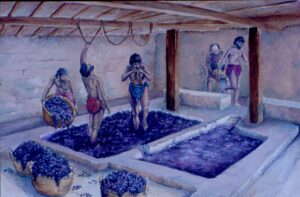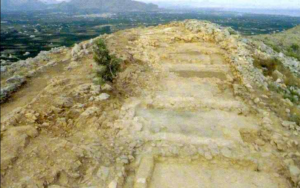Biography
EL ALT DE BENIMAQUÍA (DÉNIA, ALICANTE): LOS INICIOS DEL VINO EN OCCIDENTE
Dr. Carlos Gómez Bellard
Catedrático de Arqueología
Departamento de Prehistoria, Arqueología e Historia Antigua
Facultad de Geografía e Historia
Universitat de València
El Alt de Benimaquía fue sondeado en 1960 por el Dr. H. Schubart y excavado entre 1989 y 1992 por el Depto. de Arqueología de la UV. Supuso la comprobación de la antigüedad de la producción de vino en Occidente.
Se trata de un poblado en altura (220 s.n.m.), que domina la llanura costera por un lado y tiene también una amplia visibilidad sobre el mar. Está delimitado al N y al O por una muralla de piedra seca que tiene seis bastiones cuadrangulares, mientras que el lado sur un fuerte precipicio proporciona una excelente protección natural.
Es un poblado con calle central, sobre la que se abren diferentes habitaciones de planta rectangular. Los muros presentan zócalo de piedra y el resto de adobe, con los suelos también de arcilla batida. De los 16 departamentos excavados, dos estaban vacíos, y varios ofrecieron una enorme cantidad de material diverso, siendo probablemente almacenes. Pero sin duda lo que hace del ABq un lugar excepcional son las cuatro habitaciones que contenían una prensa de vino cada una. El hallazgo de varios miles de pepitas de uva y decenas de ánforas confirman la producción de vino en el lugar, la más antigua documentada en el Mediterráneo occidental.
Los abundantes hallazgos han permitido fechar el yacimiento y acercarse a su interpretación. Fue construido en el último cuarto del s.VII y abandonado a mediados del s.VI a.J.C.. La cerámica es a mano (30%), de tradición indígena local, y a torno (70%). Ésta la componen sobre todo ánforas fenicias tipo Rachgoun-1 (o Ramon 10.1.1.0.), producidas en Andalucía. Pero hay también numerosas imitaciones locales, que prueban el interés por envasar el vino producido. Se documentan igualmente varias ánforas Cintas 268 (o Ramon 2.1.1.0), procedentes de Cartago, cuencos, botellas, pithoi y un plato de engobe rojo.
El lugar ha sido interpretado como la residencia de un jefe que, aleccionado por los comerciantes fenicios, inicia una producción de vino excedentaria que se integra en la red comercial que incluye Ibiza y la costa mediterránea peninsular.
THE ALT OF BENIMAQUÍA (DÉNIA, ALICANTE): THE BEGINNINGS OF WINE IN THE WEST
Dr. Carlos Gómez Bellard
Professor of Archaeology
Department of Prehistory, Archaeology and Ancient History
Faculty of Geography and History
University of Valencia
The Alt of Benimaquía was explored in 1960 by Dr. H. Schubart and excavated between 1989 and 1992 by the Department of Archaeology of the University of Valencia. It proved the antiquity of wine production in the West.
It is a high-altitude settlement (220 a.s.l.), overlooking the coastal plain on one side and with a wide view of the sea. It is bounded on the north and west by a dry-stone wall with six quadrangular bastions, while on the south side a steep cliff provides excellent natural protection.
It is a settlement with a central street, on which different rectangular rooms open up. The walls have a stone plinth and the rest is made of adobe, and the floors are also made of beaten clay. Of the 16 rooms excavated, two were empty, and several of them contained an enormous quantity of diverse material, probably storage rooms. But what undoubtedly makes the ABq an exceptional site are the four rooms that each contained a wine press. The discovery of several thousand grape pips and dozens of amphorae confirm wine production at the site, the oldest documented in the western Mediterranean.
The abundant finds have made it possible to date the site and to come closer to its interpretation. It was built in the last quarter of the 7th century and abandoned in the mid-6th century BC. The pottery is hand-made (30%), in the local indigenous tradition, and pottery made on a potter’s wheel (70%). These are mainly Phoenician amphorae of the Rachgoun-1 (or Ramon 10.1.1.0.) type, produced in Andalusia. But there are also numerous local imitations, proving the interest in packaging the wine produced. Several Cintas 268 (or Ramon 2.1.1.0) amphorae from Carthage, bowls, bottles, pithoi and a red engobe dish are also documented.
The site has been interpreted as the residence of a chief who, having been instructed by Phoenician traders, began a surplus wine production that was integrated into the trade network that included Ibiza and the Mediterranean coast of the Iberian Peninsula.




